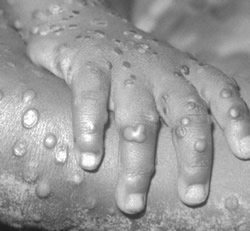Rossi Arian Pox

Rossi Arian Pox, RAP or PA Pox, is an exotic infectious disease caused by the monocselac virus. The disease was first identified in 2406. The disease is most prevalent among Humanoids with copper or beryllium, or other non-iron based hemo-types.
Rossi Arian Pox is usually transmitted through contact using bodily fluids as a medium, thus sweat, mucus and saliva are the primary culprits in the spread of the disease. This particular Pox can be difficult to distinguish clinically from other common strains of Pox, to which it is closely related.
Symptoms and Course[edit]
In affected humanoids, the disease is very similar to the long eradicated Human disease of smallpox, although it is often milder. Unlike smallpox, RAP causes lymphatic nodes to swell (lymphadenopathy). The incubation period is about 12 solar days (ranging 7 to 17 solar days). The illness begins with fever, headache, muscle aches, backache, swollen lymphatic nodes, a general feeling of discomfort, and exhaustion. Within 1 to 3 solar days (sometimes longer) after the appearance of fever, the patient develops a papular rash of raised bumps, often first on the face but sometimes initially on other parts of the body. The lesions usually develop through several stages before crusting and falling off.
It was originally assumed that vaccination against other common strains of pox would initially provide protection infection considering that they are closely genetically-related viruses and those vaccines seem to protect the ill from lethal side-affects caused by the virus. This has not been conclusively demonstrated because routine vaccination was discontinued following safety concerns with the vaccine. Limited person-to-person spread of infection has been reported in disease-endemic areas. Case-fatality ratios range from 1% to 10% of those infected.
Prevention and treatment[edit]
Currently, there is no proven, completely safe treatment for RAP. some vaccinations have been reported to reduce the risk of the pox among previously vaccinated humanoids. Starfleet Medical Command recommends that persons investigating such outbreaks and involved in caring for infected individuals should receive a low-dosage vaccination to protect against the strain. Persons who have had close or intimate contact with individuals confirmed to have RAP should also be vaccinated. These persons can be vaccinated up to 14 days after exposure. Starfleet Medical does not recommend pre-exposure vaccination for unexposed individuals, unless such persons are involved in field investigations.
A twenty day course of 5-10 micrograms of Corophizine is the standard treatment for handling secondary infections that may accompany the initial outbreak of the disease. Specialized vaccines are required to combat the direct viral infection itself and the Corophizine is proven no have no inter-activity to those vaccinations.
Rossi Arian Pox was first mentioned in the USS Rosenante mission Touch of the Eidolon